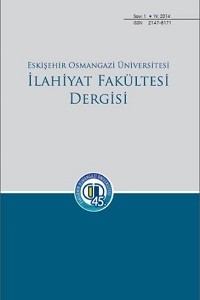Abstract
There are three main approaches about the relationship between Aql
(Reason) and Naql (the Holy Qur’an and Authentic Sunnah). Some of scholars
focus on aql and some of them focus on naql. Without subordinating one to the
other and by accepting both principles as the main sources, combine and
reconciliation method must be followed. Those who focus entirely naql brings
the apparent meaning of texts (Quran and Hadith) into the forefront and they
couldn’t deal with the contradiction between the knowledge and apparent
meaning. There are two main methods for the Islamic disciplines like fıkh, tafsir and
hadith.
1.Text (Quran and Hadith) based rationalism which is developed and
systematized by İbn Teymiyye.
2.Kalamic Rationalism which is started by Mu’tezile, developed by Ahl Sunnah
scholars and came to a head by Gazali and Fahreddin Razi.
Those two methods determine how we deal with the problems in Islamic
disciplines. New Salafi thought follows the text (Quran and Hadith) based
rationalism. Kalamic rationalism understands the immanent logic of Quran,
acknowledges the basic principles and intent of Quran as constant values,
approaches the every logical explanation without fear of losing faith, and follows
a method which determined its researches in accordance to this approaches.
Because of those features Kalamic rationalism is more successful to solving
problems than text (Quran and Hadith) based rationalism. Another point is text
(Quran and Hadith) based rationalism keeps the human mind in a narrow
framework but Kalamic rationalism surrounds the epistemic universe of
humanity and builds the roof of the house of knowledge.
Keywords
Abstract
Akıl nakil münasebeti konusunda üç ana yaklaşım bulunmaktadır. Kimi
bütün dikkatini nakle kimi de akla odaklamıştır. Birini diğerine tabi kılmadan
her ikisini de asıl kabul edilerek cem ve uzlaştırma yöntemi izlenmelidir.
Tamamen nakle odaklananlar nassların zahirini gereğinden fazla ön plana çıkarır,
zahiri anlamlar ile malukat arasındaki çelişkileri gideremezler. Fıkıh, tefsir, hadis
gibi İslâmî ilimlerle meşgul olanların önünde iki temel yöntem bulunduğu
kanaatindeyiz.
1.İbn Teymiye’nin geliştirip sistematik hale getirdiği nasscı akılcılık.
2.Mu‘tezile’nin başlatıp, Ehl-i Sünnet kelâmcılarınca geliştirilerek Gazâlî ve
Fahreddin Râzî ile zirveye ulaşan kelâmî akılcılık. Kanaatimizce bu iki temel
yöntem İslâmî ilimlerde meseleleri ele alış tarzımızı belirlemektedir. Yeni selefîlik
nasscı akılcılığa göre hareket ederken kelâmî akılcılık Kur’an’a içkin mantığı
kavrayarak, Kur’an’ın temel ilkelerini, makâsıdını sabiteler olarak belirleyip aklın
ürettiği her malzemeyi imanı kaybetmekten korkmadan ele alan ve bilginin
konusu yapan araştırmalarını ve istidlallerini de buna göre düzenleyen bir yöntem
takip etmektedir. Sayılan özellikleri nedeniyle kelamî akılcılık nasscı akla göre
yeni problemlere çözüm bulmada daha başarılı olmaktadır. Başka bir husus nasscı
akılcılık insan bilgi ve aklını dar ve sınırlı bir çerçevede tutarken, kelâmî akılcılık
insanın tüm epistemik evrenini kuşatmakta, bilgi evinin çatısını kurmaktadır.
Keywords
Details
| Other ID | JA99HU52SY |
|---|---|
| Journal Section | Articles |
| Authors | |
| Publication Date | June 1, 2014 |
| Submission Date | June 1, 2014 |
| Published in Issue | Year 2014 Volume: 1 Issue: 1 |
Journal of Eskisehir Osmangazi University Faculty of Theology (ESOGUIFD) is licensed under a Creative Commons Attribution Non-Commercial 4.0 International license.


